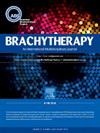The use of Monte Carlo simulation techniques in brachytherapy: A comprehensive literature review
IF 1.7
4区 医学
Q4 ONCOLOGY
引用次数: 0
Abstract
Monte Carlo techniques have become crucial in brachytherapy since their introduction in the early 1980s, offering significant improvements in source parameter characterizations, and dose calculations. It provides precise dose distributions by modeling complex radiation interactions and can be determine doses in nonhomogeneous detailed cases. They are not affected by experimental artifacts, unlike traditional detectors, and can distinguish between primary and scatter dose components. However, MC techniques have limitations. They are susceptible to systematic errors and require thorough validation against experimental data, despite generally showing smaller standard deviations. Additionally, MC simulations can be computationally intensive and depend heavily on accurate input data and models. Recent research, including 1433 publications identified up to October 2024, highlights the ongoing development and application of MC techniques in brachytherapy. Of these, 426 articles met the inclusion criteria for relevance. This comprehensive review aims to help brachytherapy researchers to identify the appropriate MC code depending on the application in BT research. Of the forty-five MC codes used in BT, MCNP is noted as the most widely used MC code due to its robust modeling capabilities in various materials and geometries. AAPM TG-186 and TG-372 reports have recommended the use of model base dose calculation algorithms, since it can offer more accurate dose calculations over TG-43 formalism, particularly in heterogeneous tissues. Despite these recommendations, further research is needed to refine dosimetry for various isotopes, geometry and media. In essence, MC techniques have greatly enhanced the accuracy, precision and flexibility of brachytherapy techniques, though challenges such as systematic errors, heterogeneities corrections, and high computational demands remain. Continued research and development of MC codes and algorithms are essential for advancing the field and improving clinical outcomes.
蒙特卡罗模拟技术在近距离放射治疗中的应用:综合文献综述。
蒙特卡罗技术自20世纪80年代初引入以来,在近距离治疗中变得至关重要,在源参数表征和剂量计算方面提供了重大改进。它通过模拟复杂的辐射相互作用提供精确的剂量分布,并可以在非均匀的详细情况下确定剂量。与传统的探测器不同,它们不受实验伪影的影响,并且可以区分初级剂量成分和散射剂量成分。然而,MC技术有其局限性。它们容易受到系统错误的影响,需要对实验数据进行彻底的验证,尽管通常显示较小的标准偏差。此外,MC模拟可能是计算密集型的,并且严重依赖于准确的输入数据和模型。最近的研究,包括截至2024年10月确定的1433份出版物,突出了MC技术在近距离治疗中的持续发展和应用。其中,426篇文章符合相关性纳入标准。本文旨在帮助近距离治疗研究人员根据BT研究中的应用确定合适的MC代码。在BT中使用的45种MC代码中,MCNP被认为是使用最广泛的MC代码,因为它在各种材料和几何形状中具有强大的建模能力。AAPM TG-186和TG-372报告建议使用模型基础剂量计算算法,因为它可以提供比TG-43形式更准确的剂量计算,特别是在异质组织中。尽管有这些建议,需要进一步的研究来改进各种同位素、几何形状和介质的剂量测定。本质上,MC技术极大地提高了近距离治疗技术的准确性、精密度和灵活性,尽管系统误差、异质性校正和高计算需求等挑战仍然存在。MC代码和算法的持续研究和开发对于推进该领域和改善临床结果至关重要。
本文章由计算机程序翻译,如有差异,请以英文原文为准。
求助全文
约1分钟内获得全文
求助全文
来源期刊

Brachytherapy
医学-核医学
CiteScore
3.40
自引率
21.10%
发文量
119
审稿时长
9.1 weeks
期刊介绍:
Brachytherapy is an international and multidisciplinary journal that publishes original peer-reviewed articles and selected reviews on the techniques and clinical applications of interstitial and intracavitary radiation in the management of cancers. Laboratory and experimental research relevant to clinical practice is also included. Related disciplines include medical physics, medical oncology, and radiation oncology and radiology. Brachytherapy publishes technical advances, original articles, reviews, and point/counterpoint on controversial issues. Original articles that address any aspect of brachytherapy are invited. Letters to the Editor-in-Chief are encouraged.
 求助内容:
求助内容: 应助结果提醒方式:
应助结果提醒方式:


